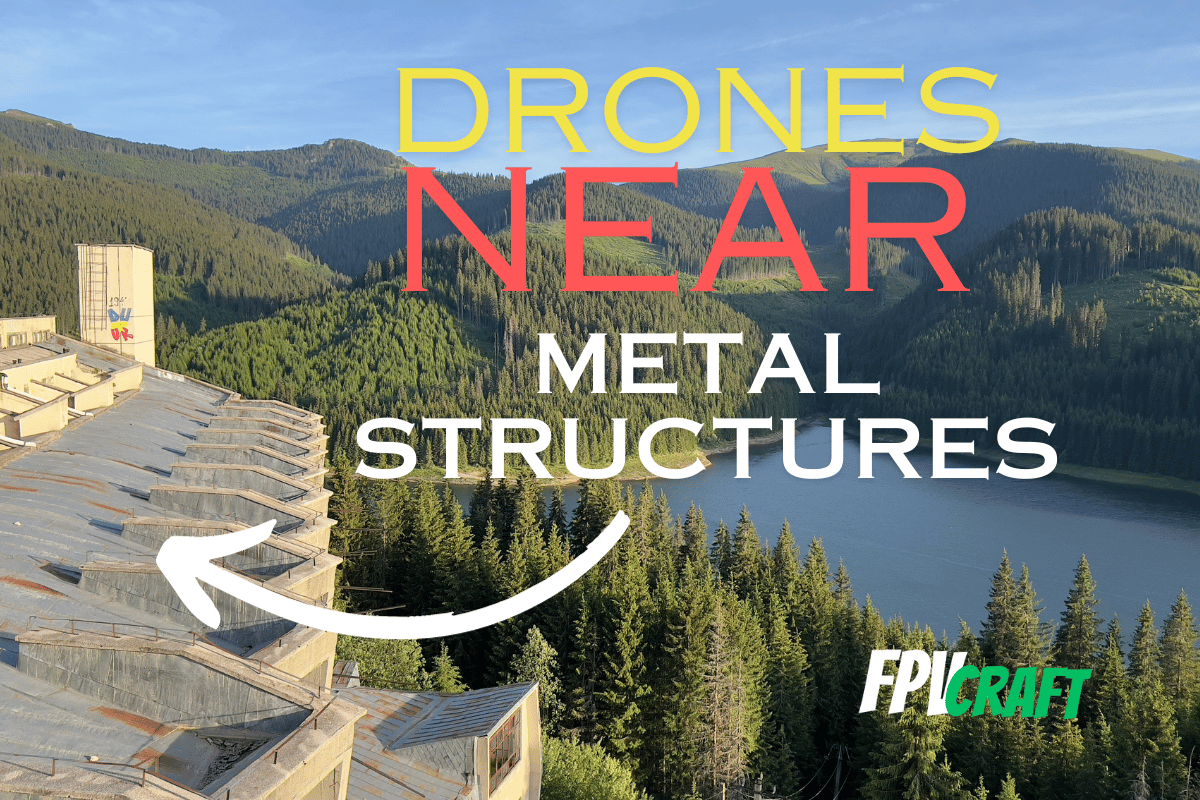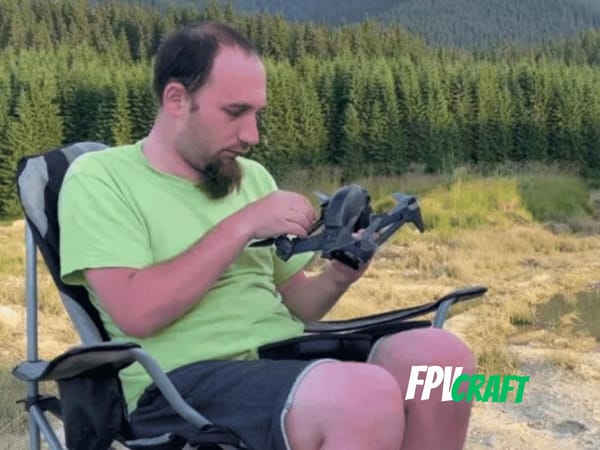Flying a Drone Near Metal Structures
Is flying a drone near metal structures a good idea? How are drones affected near metals? Let's find it out in this article.

Drones are sensible devices with many internal parts and sensors that can be disturbed if flown beyond optimal conditions or places.
And one of the issues we’re asking is about flying a drone near metal structures.
To give you a quick answer, if you fly a drone near or inside large metal structures, the GPS could be restricted entirely, and the compass can be decalibrated. The drone can act erratically, and you will have difficulty flying, but it shouldn’t crash by itself.
However, there’s a lot more to cover than that. That’s why we recommend you remain with us, as we will share everything you want to know about flying a drone near large metal structures.
What are metal structures, and does it affect drones?
A metal structure is usually a building, hall, or, in our case, a large construction made of iron, steel, or other materials, either partially or entirely.
In general, metal has excellent electrical conductivity but, at the same time, can interfere with or block radio and other types of signals.
If electrical conductivity goes through the metal structure (e.g., electrical fence), this can affect a drone’s internal sensing system even more.
But as we don’t find this in buildings, we have to think about tall constructions with many resistance metal structures or a warehouse made entirely of metal sheets.
Metal structures blocking GPS signal.
Have you noticed sometimes, if you have a GPS device indoors, this will have a hard time locating satellites?
It’s not necessarily because of metal structures but many layers of concrete that will reduce the GPS signal drastically.
However, if this building has a metal structure in it, the GPS signal could be entirely blocked.
The same will happen when you want to fly a drone indoors or in a hall. The most consequential possibility would be for the GPS signal to be cut off and the drone to acquire zero satellites.
This mostly depends on the size and thickness of the metal structure, but you always have to remember GPS will likely not work indoors, especially if the construction is made partially or entirely of metal.
The GPS signal can also be affected if you fly near such structures and not necessarily inside.
As many drones will horizontally hover based on GPS accurate positioning, be aware that this drone’s ability can be drastically impacted.
It would be, like someone says, driving on ice.
Your drone can drift and likely doesn’t brake automatically, so you must be very gentle with your controller sticks.
The visual positioning system of a drone will try to compensate for side drift, but it won’t be as near as effective when working together with GPS positioning.
» READ MORE: What Is the Maximum Service Ceiling of a Consumer Drone?
DJI drones to restrict height limit with no GPS
It can be common to encounter restrictions while flying your DJI drone and have no GPS, such as a height restriction of 10-15 feet.
This may differ from one drone to another and not always apply, but it is common across many DJI drones.
Therefore, if you have to fly near a tall metal building where there’s a possibility of cutting the GPS signal, expect your drone to restrict your height.
» READ MORE: How High can DJI FPV Fly?
Metal structures affecting a drone’s compass
A drone compass has the function of the drone to know its direction based on the Nordic magnetic field.
In places with electromagnetic interferences, the compass of a drone can go haywire.
Although metal structures do not produce electromagnetic interferences, these can be expected to block the fine magnetic field entirely.
So a compass won’t work in a metal building or a drone compass.
Without a compass, the drone will lack orientation, and if you own a DJI drone, you’ll have issues even launching it.
Note: Be sure you won’t attempt to calibrate the compass around any metal structure
Can the height stability of a drone be affected?
Although GPS can be accurate at maintaining a horizontal position, it’s not precise when calculating heights.
In our case, GPS or No GPS should not affect the drone height stability. Not yet, at least.
Instead, most drones use a barometer, which can calculate the altitude from the takeoff point due to changes in atmospheric pressure.
However, usually close to the ground, this won’t get an accurate reading.
In this case, a downward vision system and ultrasonic sensors come in place for accurate readings and keep the drone stable at the same altitude.
Now, to give you a final answer, although a drone may drift on a side because of no GPS location near metal structures, the drone should be able to maintain an accurate height position, but this depends on the sensor.
For visual sensors, if the ground or structure has a reflective surface, this may fail to get an accurate reading.
» READ MORE: Is DJI Avata at Risk of Tumbling?
Can metal structures block a drone’s signal?
This is the million-dollar question.
Short answer? Absolutely yes. Both RF and video transmission signals can be drastically affected by metal structures.
When a radio signal gets near a metal structure, it tends to bounce back, but not all of it.
If you have a drone on the other side of a metal structure, chances are the signal remains strong enough to provide a link with the drone but at a decreased rate.
But not always.
Depending on the drone transmission power, even a metal layer can entirely block the radio or video signal between the pilot and the drone.
However, there’s a catch to play, especially with FPV drones.
You can usually increase power (for instance, from 25mW all the way up to 1W), and with more power, there are higher chances to penetrate a metal layer for a better signal.
And that’s okay, but now the catch.
If you increase too much, the RF signal will be too strong and bounce back a lot more, interfering with your RC, goggles for FPV drones, and everything around in general.
So, too little means not enough to penetrate. With too much power, the signal will spike, bounce back, and create interference.
That’s why if you can change the transmission power of your RX or VTX when flying near metal structures, be aware of this.
» READ MORE: Standard GPS Drones vs. FPV Drones Video Latency
How metal structures affect a drone wind stability
Although a drone is stable enough to fly even in high winds, without GPS positioning, the drone can slightly drift and have difficulties hovering in place.
Remember that we have issues with GPS near or inside large metal buildings?
Now, if there are air currents (far below the average drone max wind speed), some drones may fail to stabilize themselves to wind, causing further drift.
So, just be aware that if you fly in a junkyard or construction site with a lot of metal that could potentially block your GPS signal, and on a windy day, the drone can lose control.
» READ MORE: DJI FPV Wind Resistance (explained)
Can a drone crash if flying near metal structures?
The drone itself won’t crash or simply fall out of the sky.
But all these interferences and signals blocked will significantly impact the drone’s typical flight characteristics.
Such a drone will be harder to control, riskier, have higher sensitivity, have difficulties orienting or hovering, and that’s on top of possible signal loss.
Once more, be alert and take it slow if you really have to fly a drone near metal structures.
Fly standard vs. FPV drones near metal structures?
Well, about everything we have covered in this topic reflects a standard GPS drone (hence, DJI) internal sensing system and modules that could be affected when flying near or inside metal structures.
But not FPV drones.
Flying FPV drones in acro mode, you will manually stabilize them, hover, and keep direction. An FPV drone will not benefit from any of these internal sensing systems that can affect a regular drone.
Moreover, rarely an FPV drone has a GPS module. But even like that, this module is simply for rescue mode only.
The only thing affected if you fly FPV near or inside metal structures is the signal strength.
» READ MORE: Standard GPS Drones vs. FPV Drones Video Latency
Tips for flying a drone near metal structures
- Don’t use waypoints or any intelligent functions: Even if the drone manages to lock in some satellites, don’t try to use any intelligent functions such as Waypoints on DJI drones because there’s a risk of losing the GPS signal, and the drone could act aimlessly.
- Change the safety feature on signal lost to hover: Usually, with DJI and other drones, when you lose signal with it, the drone will act accordingly and either set a preestablished way back based on GPS location (return to home), hover, or auto land. The best would be to set the drone to auto land as if you will often lose signal to the drone between metal structures to avoid this initializing auto return to home, whether there’s a GPS lock or not.
- Keep an eye on all these parameters: Flying between metal structures, inside warehouses, and other metal constructions can haywire a drone’s sensing system. It would be best always to keep an eye on all the OSD parameters to ensure nothing goes bad.
- Tripod feature: With a lack of GPS signals, as drones are susceptible to such flights, setting it to tripod mode will decrease the drone speed, maneuverability, and rates, which could be an excellent approach to ensure safer flights.
- Propeller guards: I would personally not fly a drone inside a metallic hall or junkyard without some essential protection for the drone. Although I would mostly recommend custom FPV cinewhoop drones for such flights, propeller guards may be appropriate to protect the drone from potential low-speed collisions if this isn’t possible.
Frequently Asked Questions
Can drone signals be blocked by normal structures?
Anything between you and the drone can drastically reduce the radio signal, but not as much as a metal structure.
Does flying above metal structures affect drone signals?
As long as you are not in the vicinity of the metal structure and you have a visual line of sight with the drone (for best performance), if the drone flies above the metallic structure, this shouldn’t be affected, as long as you don’t approach it too much.
I have lost my drone signal when flying near a metal building. What to do?
First thing, don’t panic. If you have listened to our advice and set the drone on auto land when the signal is lost (due to poor or lack of GPS signal, affected by metal structures), you can simply approach the drone and try to establish a link.
However, be aware that if you have set your drone to hover, this will be affected by a lack of GPS (if you don’t have any), which can drift.
It’s important to know if you have to set your drone to return to home, hover, or auto land, depending on many circumstances.




